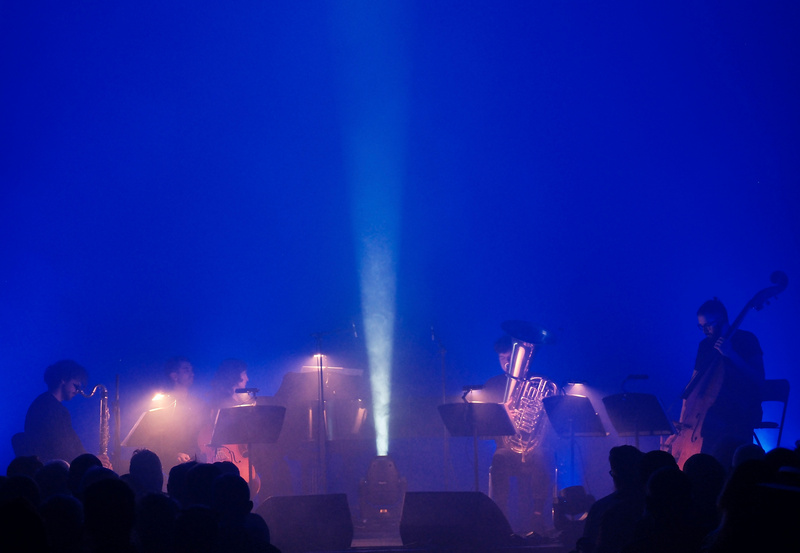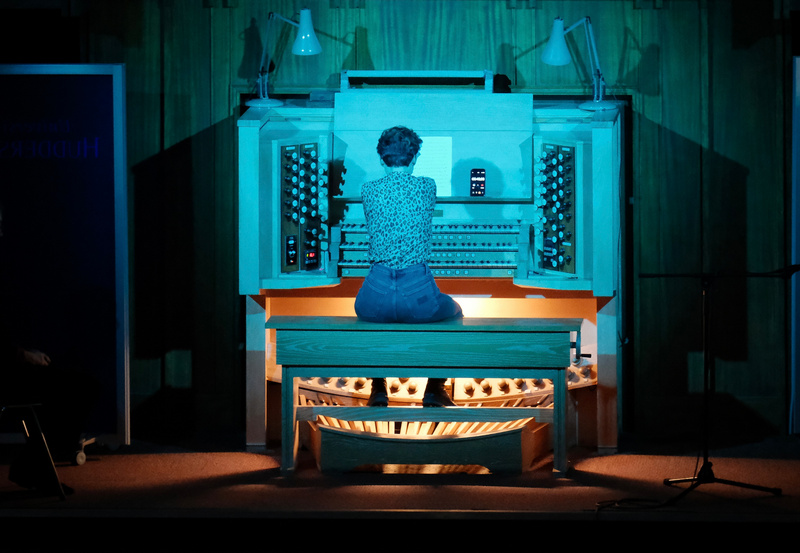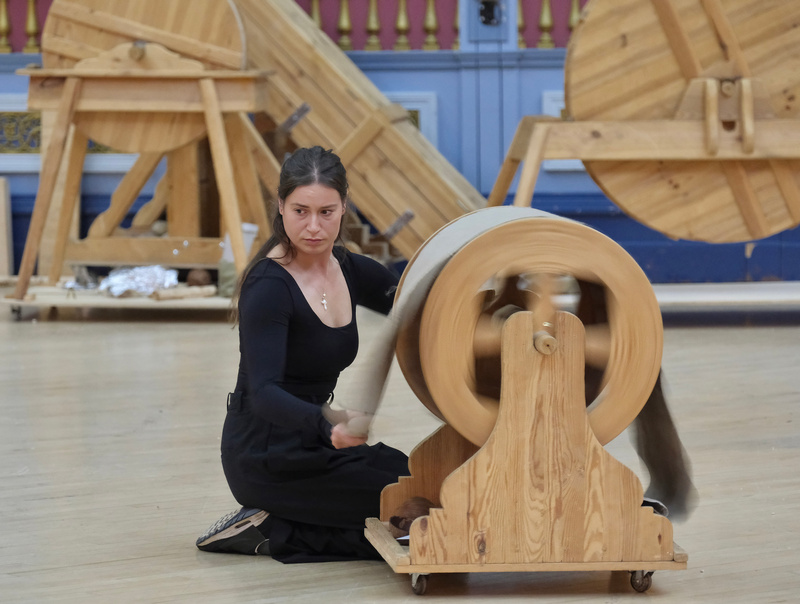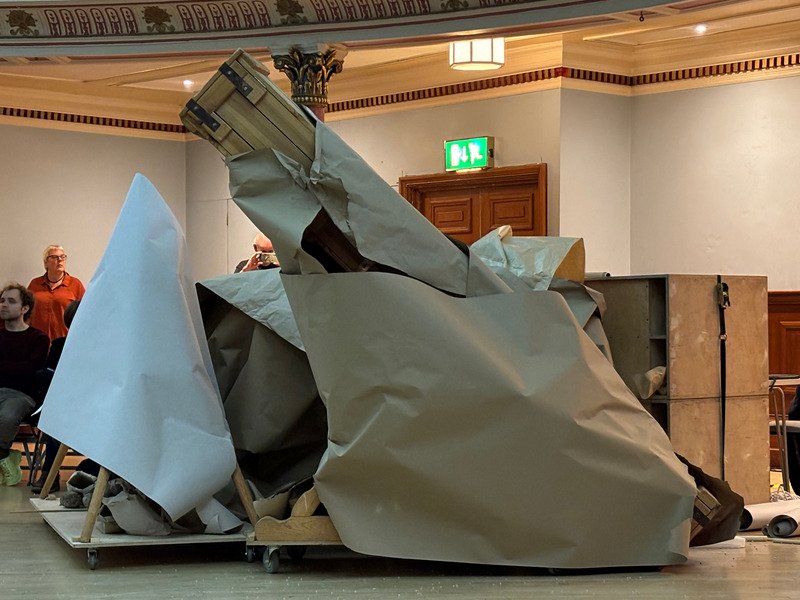
Ambient modes of expression, and listening, were brought to bear on two large-scale works during my long weekend at HCMF, both by Lithuanian composers. The less successful of the two was Hadal Zone by Žibuoklė Martinaitytė, which sought to be an hour-long sonic descent into the most abyssal oceanic depths. Performed by Ensemble Synaesthesis in the suitably spacious environment of Bates Mill Blending Shed, the work began literally, evoking surface sounds of splash and spray that soon yielded to a more abstract environment.
i’ve been impressed by Martinaitytė’s work previously (her ensemble piece Solastalgia was featured in my 2022 Lent Series), so it was disappointing to hear the piece unfold as an extremely generic example of dark ambient noodling. There was certainly a sense of atmosphere, but dark ambient suffers more than most from the fallacy that atmosphere alone is sufficient, and while Martinaitytė was clearly aiming to do more than just that, Hadal Zone was nonetheless surprisingly simplistic and unoriginal. Repetitive piano phrases, pseudo-ethereal voices, roaming low register phrases and gestures, all of it coming across as stylistically borrowed and narratively arbitrary. Nothing definite, everything provisional, a continual stream of “why not?” rather than “because”, along the way drawing perilously close to New Age tropes that have been endlessly done to death. Despite some occasionally nice moments (including a sequence evoking throat singing) it was nonetheless style over substance, material in the service of atmosphere, the kind of thing one would expect to hear in the far more conservative environs of a late night concert at the Proms. Considering its inspiration, it’s a sad irony that Hadal Zone had little to no sense of depth.

Much more impressive was Stand-by for Minna, a 45-minute organ work by Arturas Bumšteinas, receiving its world première. Incorporating fragments and loops of music by English composer Minna Keal, the most beguiling aspect of the piece was its layering. Some of these were largely static, others repeated, while still others progressed and developed – it was mesmeric, an intricate mix of active and passive elements that seemed to exist outside notions of consonance and dissonance. Apropos: at times it sounded as if there could plausibly be an otherwise clear harmonic progression playing out within or below some of these layers of complication, but Bumšteinas kept us guessing as to whether or not it was really there or just a trick of the concentric circles of sound. The nature of the repetitive elements kept changing, leading to a mode of listening that could range freely from a broad perspective – taking in all the layers simultaneously – to a focusing in on specific layers or elements. It was like being lost within a vast mechanism constructed from nothing more than different kinds of vibration.

Utterly different soundworlds filled the Sunday afternoon concert given by Ensemble Nikel. Even now, over a week later, my mind is still going over the first performance of La Nitroglycérine des Lumières by Steven Daverson. At the time it all felt impenetrable: the programme note referenced the Lumière Brothers’ short film La Démolition d’un mur, suggesting some (unnecessarily explosive) connection; the piece itself was clearly lyrical at its heart but low-key gnarly, volatile at times but also lent a nocturnal flavour by its resonance, and on top of that this short 12-minute work apparently took a period of 6 years (2017-2023) to create. Nothing about it was immediate or made sense, but i absolutely enjoyed it – whatever it was. Definitely a piece i want and need to experience again.
More tangible was Ext.TheWoods.Night, by Turkish composer Didem Coskunseven, a piece that also cited film as inspiration, in this case the idea of a nocturnal ‘sonic script’. It was a deeply heady experience, initially comprised of dark, halting fragments that sounded as if they were the only moments of something more substantial to emerge from an otherwise inescapable gloom. Even when Coskunseven allowed them to protrude more forcefully they remained just as ephemeral, leading to a nicely hard-to-read attitude caught between rest and tension, possibilities of peace or poise. Certainly as it continued the music seemed more overtly relaxed, now occupying a heavily reverberant, dreamy, unreal environment, shimmering and swimming before our ears, with the strange sense of a returning bassline making it all seem like a defocused kind of passacaglia. With a few details eventually becoming teased to the surface towards the end, it was an absolutely hypnotic performance of a remarkable piece.

The same was true – though it’s putting it mildly – for Rebecca Saunders‘ Us Dead Talk Love, the UK première of which brought Ensemble Nikel’s concert to an end. They were joined by vocalist Noa Frenkel, who instantly established herself as the most perfect singer to have ever articulated Saunders’ unique musical language. Simply ravishing from the outset, Frenkel and Nikel were utterly inseparable, together forming a single, timbrally complex voice. Its vocabulary was volatile, erupting in instrumental clusters while Frenkel spanned the gamut of dynamic and dramatic possibilities, one moment forceful, the next whispering, now constricted, now desperate, then unleashing pure song. Though the specifics of the text were often difficult to parse, it clearly traversed a similarly fluid continuum from emotional expression to more aloof forms of description, the whole transmitted (as with all Saunders’ output) as something imperative and vital. i’ve realised i tend to stop breathing during Saunders’ music, and that felt more than usually unavoidable in Us Dead Talk Love, due to it having no moments of repose. Indeed, it was like a compositional ‘circular breathing’, perpetually inhaling for what’s next while exhaling what was happening now. Both the subject matter and the way Saunders handles it gives her work a distinct fetishistic quality (considering i referenced Clive Barker when previously discussing her music, this seems particularly apt), which here only heightened further its emotive energy and intensity. This was music of nerve endings, beyond time and place, primordial and ultra-modern simultaneously, almost too much to take yet impossible to turn away from. Astonishing.
Maybe this is unfair, but one doesn’t usually expect something extraordinary during HCMF’s annual ‘Shorts’ day, the Monday filled with free concerts, all of them between 20 and 40 minutes long. This year’s was the typical qualitatively-challenged smorgasbord, with rather too many safely disposable performances. Zosha Di Castri’s The Dream Feed, performed by violinist Olivia de Prato, was a small exception, inhabiting a free-wheeling dreamworld populated by an unborn baby’s heartbeat and building to a hyperenergetic finale. Due to the unexplained cancellation of Lola de la Mata’s new work quiet walls of flame, Rosie Middleton gave a short performance of the collaborative piece Use of Plastic May Cause Suffocation, another problematic example of what i discussed previously, where all the creative emphasis was on the visual and theatrical, leaving its sonic world entirely bereft of interest (it would be good to experience the entirety of PLASTIC BODIES, from which Use of Plastic comes, to appreciate the larger context). After the disappointment of PERSONHOOD on the opening night of the festival, Jennifer Walshe redeemed herself in another audiovisual piece, AN GLÉACHT. This returned to Walshe’s wonderful world of imaginary Irish avant-folk heroes – this time Caoimhín Breathnach – bringing to mind the earthy, surreal aesthetic of Mark Jenkin’s Enys Men. Brilliantly performed by Lee Patterson, Nick Roth and Úna Monaghan, its combination of highly tactile sounds with the by turns baffling and hilarious quasi-ritualistic actions shown on the accompanying film made for a surprisingly opulent blend that, for all its weirdness, was dizzyingly compelling.

But the overwhelming highlight of ‘Shorts’ day came in the afternoon performance of Arturas Bumšteinas‘ 40-minute Navigations. Events in Huddersfield Town Hall tend to involve more ambitious scale, and that was certainly the case here. Taking inspiration from the elaborate accoutrements used to create the sounds of the elements in Baroque theatre, in hindsight there was potentially a lot militating against this concert. The work, performed by a quintet comprising Gitis Bertulis, Gailė Griciūtė, Greta Grinevičiūtė, Alanas Gurinas and Ieva Rižė, used a plethora of mechanical instruments, including rain and wind machines, as well as metallic thunder sheets and collections of rocks, wooden balls, cylinders and the like. All of these were transported – in many cases, due to their large size, wheeled – around the space, and this could easily have harmed the sense of immersion, not merely breaking the spell but not even allowing the spell to take effect in the first place. This problem seemed reinforced at the start, which began with a lone performer traversing the edge of the space with a single, handheld device, practically declaring the artifice of what was about to take place. It could easily have become yet another work primarily emphasising its visual elements, in this case elaborate choregraphy and fascinating, unusual instruments.

Yet literally everything we saw was purely functional, a means to a musical end. And it was such an end: a vast elemental soundscape which, with eyes shut (which was admittedly tempting not to do) instantly became not only stunningly realistic of actual wind and rain but also clarified into a fascinating shifting sound sculpture in which music was seemingly being crafted out of actual weather. Navigations was peppered with all manner of unexpected timbres, noises and effects: peculiar pitch shapes created from different kinds of friction; ferocious thunder cracks from objects violently smacking together inside not so much rainsticks as giant ‘stormsticks’; infinitessimal droplets from the impacts of tiny fragments. Yet the verisimilitude of the piece had a flipside. With eyes open, there was something ritualistic about the performers’ movements and actions, and this came to a remarkable climax when all of the machines were transported to one side of the space, next to an anonymous, hitherto unused (and unnoticed), large square contraption. Here they were all crudely wrapped in large swathes of paper, almost like offerings being presented. The implication was that everything hitherto had been preparatory for some grand, final statement. Perhaps the large device was some kind of pseudo-deity – a literal deux ex machina – subsequently unleashing waves of bass that filled the Town Hall with juddering pulsations. This was HCMF at its very best, harnessing sound and sight such that they worked together as equal partners in a complex audiovisual composition, but where music, far from being peripheral, still less trivial, was essential, imaginative and marvellous.


What a shame I missed Navigations! Unfortunately, that was the window my friend and I had decided on for me to accompany him to his hotel (where he ditched his car) and thence by taxi to the Rat & Ratchet for a swift pint (at least it was a good pint)…